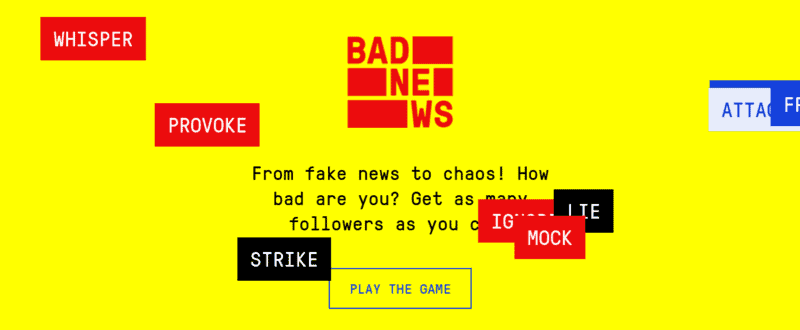Bad News comes bearing good news. The game about propaganda and disinformation, that is.

An online game that puts players in the role of propaganda producers can help them spot disinformation in real life, a new study reports. The game, christened Bad News, was effective in increasing players’ “psychological resistance” to fake news.
‘Alternative truth’
“Research suggests that fake news spreads faster and deeper than the truth, so combating disinformation after-the-fact can be like fighting a losing battle,” said Dr. Sander van der Linden, Director of the Cambridge Social Decision-Making Lab.
Researchers at the University of Cambridge helped develop and launch the browser-based video game back in February of 2018, in collaboration with Dutch media collective DROG and design agency Gusmanson. Since then, thousands of people have played the game — which takes about fifteen minutes from start to finish — with many, yours truly included, submitting their data to be used for this study.
In Bad News, your job is to sow anger and fear by creatively tweaking news and manipulating social media. Throughout the game, you’ll find yourself calling on twitter bots, photoshopping ‘evidence’, and churning conspiracy theories to attract followers. It’s quite a good game, and a pretty eye-opening one at that, because you have to walk a very thin line. On the one hand, you want as many people as possible to start following and believing you; on the other hand, you need to rein yourself in somewhat to protect your “credibility score”.
What the team wanted to determine is whether the game can help people spot fake news and disinformation in real life. The results suggest it can.
“We wanted to see if we could preemptively debunk, or ‘pre-bunk’, fake news by exposing people to a weak dose of the methods used to create and spread disinformation, so they have a better understanding of how they might be deceived,” Dr. van der Linden explains. “This is a version of what psychologists call ‘inoculation theory’, with our game working like a psychological vaccination.”
Players were asked to rate the reliability of a series of headlines and tweets before and after gameplay. Participants were randomly allocated a mixture of real (the control group) and fake news (the “treatment” group). The team reports that members in the treatment group were 21% less likely to perceive fake news headlines as reliable after playing the game. Bad News had no impact on how these participants ranked real news in terms of reliability.
There are six “badges” people can earn in the game for the six most common strategies used by fake news producers today: impersonation; conspiracy; polarisation; discrediting sources; trolling; emotionally provocative content. In-game questions measuring the game’s impact were issued for four of these badges (to limit bandwidth usage). From pre- to post-gameplay, the results show that Bad News:
- Reduced perceived reliability of the fake headlines and tweets by 24% or the disinformation tactic of “impersonation” — i.e. the mimicking of trusted personalities on social media.
- Reduced perceived reliability of “polarisation” — i.e. the use of highly-polarizing, emotionally-provocative headlines — by about 10%.
- Reduced perceived reliability of “discrediting” — i.e. attacking a legitimate source with accusations of bias — by 19%.
- Reduced perceived reliability of “conspiracy” — i.e. the spreading of false narratives blaming secretive groups for world events — by 20%.
Those who were most susceptible to fake news headlines at the outset of the study benefited most from this “inoculation”, the team adds.
“We find that just fifteen minutes of gameplay has a moderate effect, but a practically meaningful one when scaled across thousands of people worldwide, if we think in terms of building societal resistance to fake news,” adds van der Linden.
“We are shifting the target from ideas to tactics,” says Jon Roozenbeek, study co-author also from Cambridge University. “By doing this, we are hoping to create what you might call a general ‘vaccine’ against fake news, rather than trying to counter each specific conspiracy or falsehood.”
The team worked with the UK Foreign Office to translate the game into nine different languages including German, Serbian, Polish, and Greek. They’ve also developed a “junior version” of the game aimed at children aged 8-10 which is available in ten different languages so far. The goal is to “develop a simple and engaging way to establish media literacy at a relatively early age”, Roozenbeek explains, and then see how long the effects last.
Still, so far, the data isn’t conclusive. The major limitation of this dataset is that it used a self-selecting sample, namely those who came across the game online and opted to play. As such the results are skewed toward younger, male, liberal, and more educated demographics. Even with this limitation, the team says controlling for various characteristics showed that the game was almost equally effective across age, education, gender, and political persuasion. Part of that comes down to the fact that Bad News has an ideological balance built in, the team explains: players can choose to create fake news from the left and right of the political spectrum.
“Our platform offers early evidence of a way to start building blanket protection against deception, by training people to be more attuned to the techniques that underpin most fake news,” Roozenbeek concludes.
You can try the game out here.
The paper “Fake news game confers psychological resistance against online misinformation” has been published in the journal Nature.


